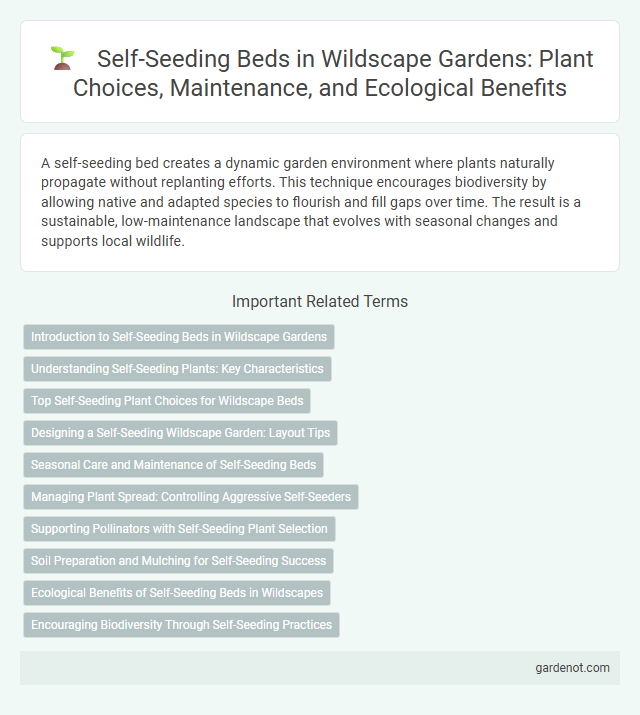A self-seeding bed creates a dynamic garden environment where plants naturally propagate without replanting efforts. This technique encourages biodiversity by allowing native and adapted species to flourish and fill gaps over time. The result is a sustainable, low-maintenance landscape that evolves with seasonal changes and supports local wildlife.
Introduction to Self-Seeding Beds in Wildscape Gardens
Self-seeding beds in wildscape gardens harness the natural regenerative ability of native plants to create sustainable, low-maintenance landscapes. These beds support biodiversity by allowing wildflowers and grasses to propagate naturally, adapting over time to local soil and climate conditions. Cultivating self-seeding beds enhances habitat resilience and provides continuous food sources for pollinators and wildlife throughout the seasons.
Understanding Self-Seeding Plants: Key Characteristics
Self-seeding plants in a wildscape naturally disperse their seeds, creating self-sustaining beds that require minimal human intervention and enhance biodiversity. These species typically produce abundant seeds with adaptations for wind, water, or animal dispersal, facilitating spontaneous germination and establishment. Understanding key characteristics such as seed viability, dormancy, and growth habits is essential for managing and encouraging a thriving self-seeding bed in naturalized garden environments.
Top Self-Seeding Plant Choices for Wildscape Beds
Top self-seeding plants for wildscape beds include native wildflowers such as Echinacea purpurea, Rudbeckia hirta, and Solidago spp., which promote biodiversity and require minimal maintenance. These species naturally disperse seeds, ensuring continuous seasonal growth and habitat support for pollinators like bees and butterflies. Incorporating self-seeding plants enhances the ecological value and sustainability of wildscape gardens by encouraging natural regeneration and soil health.
Designing a Self-Seeding Wildscape Garden: Layout Tips
Designing a self-seeding wildscape garden involves creating a habitat that encourages native plants to naturally propagate, ensuring continuous growth and biodiversity. Prioritize grouping species with compatible growth habits and planting times to maximize natural reseeding, while incorporating open spaces for seed dispersal and sunlight penetration. Incorporate layers of vegetation, from ground cover to shrubs, to support diverse wildlife and promote a resilient ecosystem.
Seasonal Care and Maintenance of Self-Seeding Beds
Seasonal care and maintenance of self-seeding beds involve monitoring seed dispersal and ensuring soil conditions remain favorable for germination. Removing excessive weeds in spring prevents competition while allowing natural reseeding to promote plant diversity. Regularly checking moisture levels during dry periods supports healthy seedling establishment and sustainable growth in wildscape gardens.
Managing Plant Spread: Controlling Aggressive Self-Seeders
Managing aggressive self-seeders in a Wildscape self-seeding bed is essential to maintain biodiversity and prevent monoculture dominance. Regular monitoring and targeted removal of excess seedlings help control spread while preserving desired native species. Incorporating mulch and strategic planting layouts reduces unwanted seed dispersal and supports sustainable ecosystem balance.
Supporting Pollinators with Self-Seeding Plant Selection
Self-seeding beds enhance habitat diversity by providing continuous blooms that attract and sustain pollinators such as bees, butterflies, and hummingbirds. Selecting native, self-seeding plants like wildflowers, milkweed, and coneflowers ensures natural regeneration and abundant nectar sources throughout the growing season. This strategy supports local ecosystems by promoting pollinator health, increasing biodiversity, and reducing maintenance efforts in Wildscape garden designs.
Soil Preparation and Mulching for Self-Seeding Success
Soil preparation is crucial for a thriving self-seeding bed, requiring loose, well-drained soil enriched with organic matter to support seed germination and root development. Mulching with a thin layer of biodegradable material helps retain moisture, suppresses weeds, and regulates soil temperature to create optimal conditions for seedling growth. Regular monitoring ensures mulch does not become too thick, allowing light penetration and air circulation essential for successful self-seeding in wildscape environments.
Ecological Benefits of Self-Seeding Beds in Wildscapes
Self-seeding beds in wildscapes enhance biodiversity by providing continuous habitats and food sources for pollinators and wildlife. These beds improve soil health through natural nutrient cycling and reduce the need for artificial inputs, promoting sustainable ecosystem dynamics. Their ability to regenerate independently supports resilience against environmental changes and preserves native plant diversity.
Encouraging Biodiversity Through Self-Seeding Practices
Self-seeding beds enhance biodiversity by allowing native plants to naturally propagate without human intervention, promoting ecological balance and habitat creation. These beds support pollinators such as bees and butterflies by providing continuous floral resources and diverse plant species that adapt to local conditions. Incorporating self-seeding practices reduces maintenance and fosters resilient ecosystems essential for wildlife sustainability.
Self-seeding bed Infographic

 gardenot.com
gardenot.com